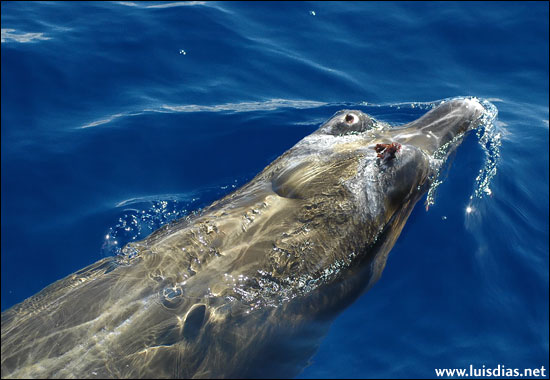Blainville's beaked whale
Blainville 's beaked whale ( Mesoplodon densirostris )
The Blainville 's beaked whale or Blainville 's beaked whale ( Mesoplodon densirostris ) is a cetacean of the family of beaked whales ( Ziphiidae ). Its name comes from the French zoologist Henri de Blainville, who described the type 1817 on the basis of a pine find.
Dissemination
Blainville 's beaked whales are the most widely used type of two toothed whales, they are found in all tropical and temperate oceans. Findings or sightings are known, among other things by the North American Atlantic coast, the Caribbean, Portugal, the western Mediterranean, South Africa, the western Indian Ocean, Japan, eastern Australia, Hawaii and the Central Pacific.
Description
With a length of 4.7 meters of Blainville 's beaked whale is one of the smaller member of its genus. It is colored light gray at the top and dark gray on the belly, whitish scars of rivals fighting parasites and of shark attacks are found on many animals. These whales have a long snout, the lower jaw is curved upwards. At this bulge grow two very large teeth which project out of the closed mouth in the males. Behind the snout is most skull is a small, clearly visible melon. The small flippers are narrow and pointed end. The small, crescent-shaped fin that is placed far back as in all beaked whales is moderately broad and ends pointed.
A special feature of the Blainville- Schnabelwals is his double - sonar.
Way of life
Blainville 's beaked whales live in tropical and temperate oceans, but prefer doing the open sea and rarely come close to the coasts. They live in small schools, which may include two to nine animals, and are considered good divers who stay up to 45 minutes under water and it also can dive very deep ( located up to a depth of 1,200 meters ). They feed on fish and squids. Like all Two toothed whales they are relatively shy and rarely seen; despite their wide distribution area we know little about them.
Threat
In small scale hunting is done on Blainville 's beaked whales, especially by whalers from the Philippines, Taiwan and Japan. Other threats to these animals are the by-catch in fishing nets, marine pollution and experiments with Sonar: it came after NATO maneuvers in 2000 and 2001, in which even low frequency sonar was used to mass strandings of whales, including Blainville and Cuvier - beaked whales.
Given the global distribution of this species is the knowledge of low, even on the total population and the level of danger no information can be given.










